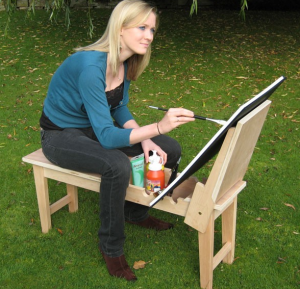30-Second Word Whoop: “Easel”
 Say “easel” aloud three times fast. EAS-el, EAS-el, EAS-el. Feel like an ass or a braying donkey?
Say “easel” aloud three times fast. EAS-el, EAS-el, EAS-el. Feel like an ass or a braying donkey?
Turns out the word does come from the Dutch ezel, originally “ass,” from the Middle Dutch esel, from the Latin asinus, or “ass.” The comparison, according to the Online Etymology Dictionary, is to “loading a burden on a donkey and propping up a painting or canvas on a wooden stand,” or a sawhorse.
Almost reduces fine art to the domain of peasants.
Rudyard Kipling’s poem The White Man’s Burden pops to mind. It was published in 1899 in Life magazine alongside this political cartoon showing imperialist bourgeoisie riding “sullen peoples” in developing countries as if they were burros.
 Easel-wise, somehow France is the country that most often comes to mind, civilized and sophisticated with accessories of paint palette and beret. An easel today can be made not only of wood but metal or Playskool plastic. You see them equally at home straddling early-education nooks and retirement retreats.
Easel-wise, somehow France is the country that most often comes to mind, civilized and sophisticated with accessories of paint palette and beret. An easel today can be made not only of wood but metal or Playskool plastic. You see them equally at home straddling early-education nooks and retirement retreats.
Interesting too how this artist’s workbench is both a tool of creation and a pedestal to display all variety of showpiece and advertisement.
Consider a starving street artist, selling her labors to afford her next meal. Art is definitely that unique field where Indigenous, simple folk and wealthy snobs intersect. As the rich rack up trips abroad, they collect trophies, displayed like stuffed game around the house.
When an artist faces a blank canvas, does she feel the burden of creation? Is it a job like any other, performed by calloused hands and measured by output?
Some of the burden is no doubt lifted by the easel, making art work a little easier.


